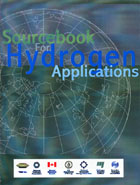
 Enter HyVIEW™
Enter HyVIEW™
Quick Links
| Hydrogen Safety Issues Hydrogen Safety Measures Comparisons Codes & Standards |
Codes & Standards
Several organizations are involved in new standards activity in response to the growth of interest in hydrogen as a fuel. The National Hydrogen Association has created Codes and Standards Working Groups on topics such as hydride storage, electolysers for home use, transportation infrastructure issues and maritime applications. The Society of Automotive Engineers, through a Fuel Cell Standards Forum Safety Task Force is collaborating with the NHA on the transportation issues. Much of this standards writing is taking place at the International Organization for Standardization (ISO) level in ISO Technical Committee 197 (Hydrogen Technologies) with input through the national organizations. The International Electrotechnical Committee, IEC TC 105 (Fuel Cells}, ISO TC 197, and ISO TC22 SC 21 (Electric Vehicles) are all involved in fuel cell standards activities.
ISO TC 197 is one of the more active standards writing groups for hydrogen. Since new standards are being developed rapidly, ISO TC 197 and the other organizations should be checked for possible new standards when considering some of these newer systems.
As production of hydrogen progresses from reforming of hydrocarbons and electrolysis to thermochemical technologies (gasification and pyrolyis of biomass) - and as the photobiological and photoelectrochemical technologies come on stream - the need for standards writing will continue.
A Checklist for Fire and Building Code Officials
Local building and fire code officials are on the front line in protecting people and structures when dangerous goods are used. In the case of new projects, the public interest is well served when a project promoter maintains close contact with local officials from a project's inception rather than seeking approvals once a project design is complete.
In the case of applying technologies in a new field such as hydrogen, this exercise can be a learning curve for both the project promoter and the local official.
Local regulators are familiar with the more common fuels. Through comparisons it is evident that, in many cases, hydrogen is much less a problem while, in others, it may be more problematic. Safe installation and operation of hydrogen systems involves two basic questions:
- Have steps been taken to ensure that the hydrogen has been safely confined?
- If hydrogen is released, have steps been taken to minimize any effects?
Key Considerations
To answer these important questions, these key considerations will prove helpful:
- Confinement
- The ASME Boiler and Pressure Vessel Code is the leading guide for containment of hydrogen in pressurized systems. In most jurisdictions in North America, it has been adopted into regulations governing pressurized systems. Other codes include the FAR and Transportation of Dangerous Goods for interstate and interprovincial transport and IMDG for international maritime transport.
- Minimizing Consequences
- The quantity of hydrogen stored, the storage technique used (liquid hydrogen, gaseous hydrogen, or metal hydrides) and whether the hydrogen is stored inside a building underground or outdoors must be taken into account. The most commonly required hydrogen standards are probably the National Fire Protection Agency standards NFPA 50A and B for the use of gaseous and liquid hydrogen (respectively) at consumer sites. Electrical devices in the presence of hydrogen are covered by such codes as the U.S. National Building Code and the National Fire Code of Canada.
- Safety Analysis
- Obtain and evaluate the promoter's safety analysis including whether it includes a satisfactory emergency response procedure and an evacuation plan.
- Review Available Information Relevant to the Project
- Try to get a good overview of hydrogen, including the applicable codes as well as information from demonstration projects of similar installations. Verify conformity to codes and standards.
- Personal Investigation
- Consider likely potential accident scenarios for the application at hand. Identify the possible leak scenarios, taking into consideration the outflow rate and the duration of the leak. Consider that room-temperature hydrogen releases rise vertically very quickly and dissipate rapidly. Note that liquid hydrogen is initially non-buoyant, and will dissipate more slowly. Remember that leaks in enclosed areas may lead to an explosion.
- Review Potential for Ignition
- Identify all potential ignition sources close to the hydrogen reservoirs, remembering that for dense hydrogen clouds, a spark from a static electricity discharge could ignite a release. The safe use of a combustible material such as hydrogen revolves around preventing situations where all three sides of the combustion triangle, namely ignition source, fuel and oxidant are present.
- Review the Need for Detectors
- Check whether hydrogen and fire detectors are warranted. Remember that hydrogen flames are nearly invisible and difficult to detect with infrared detectors. Check whether flame arrestors are warranted.
- Review Site-Specific Factors
- Check the location of office buildings, public pathways, parking lots and public gathering places with respect to the location of the hydrogen reservoirs. Take into account factors such as the direction of the prevailing winds and topography. Compare this with the location of the hydrogen detectors.

